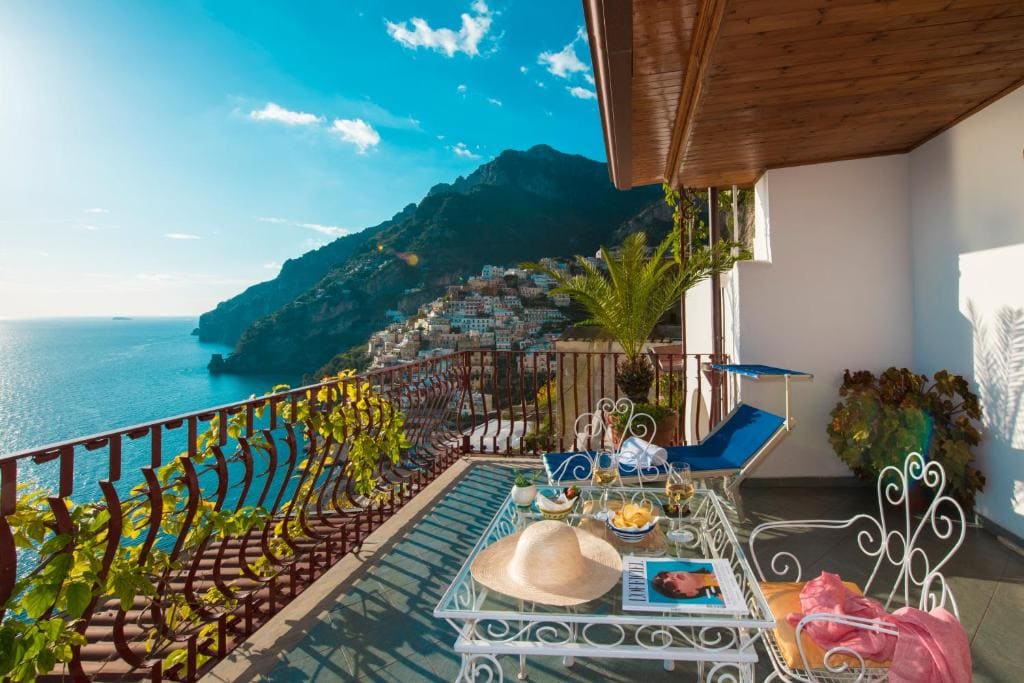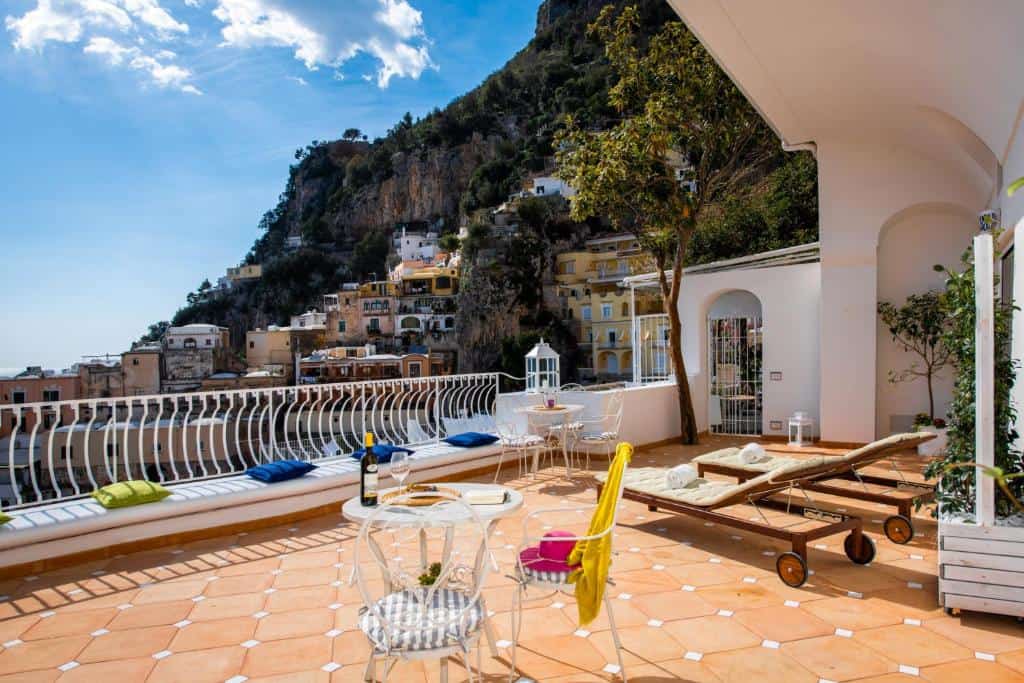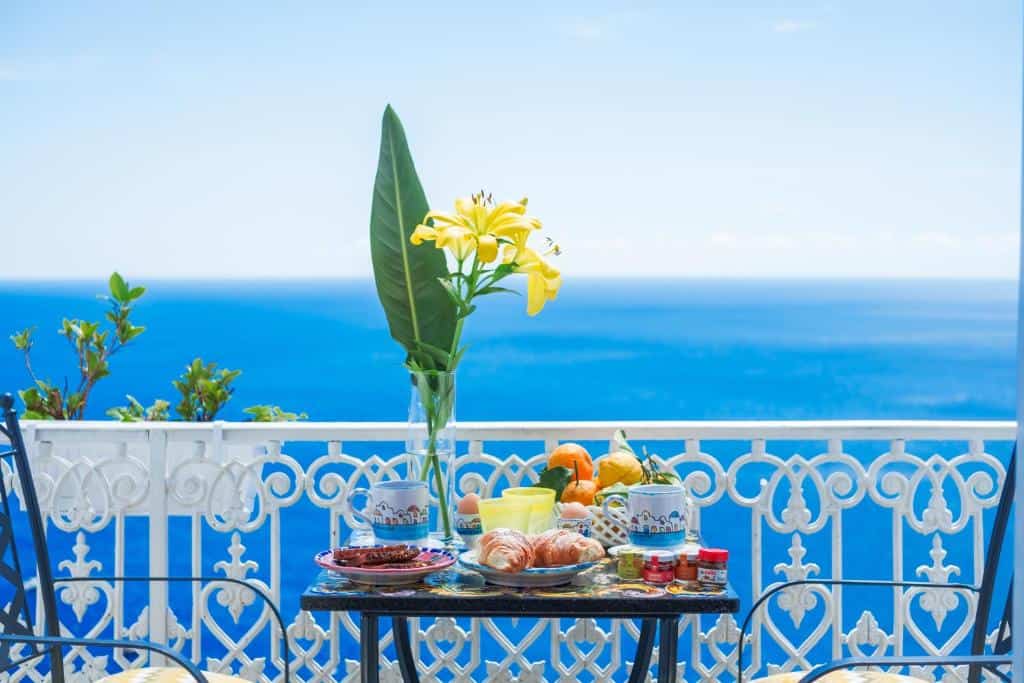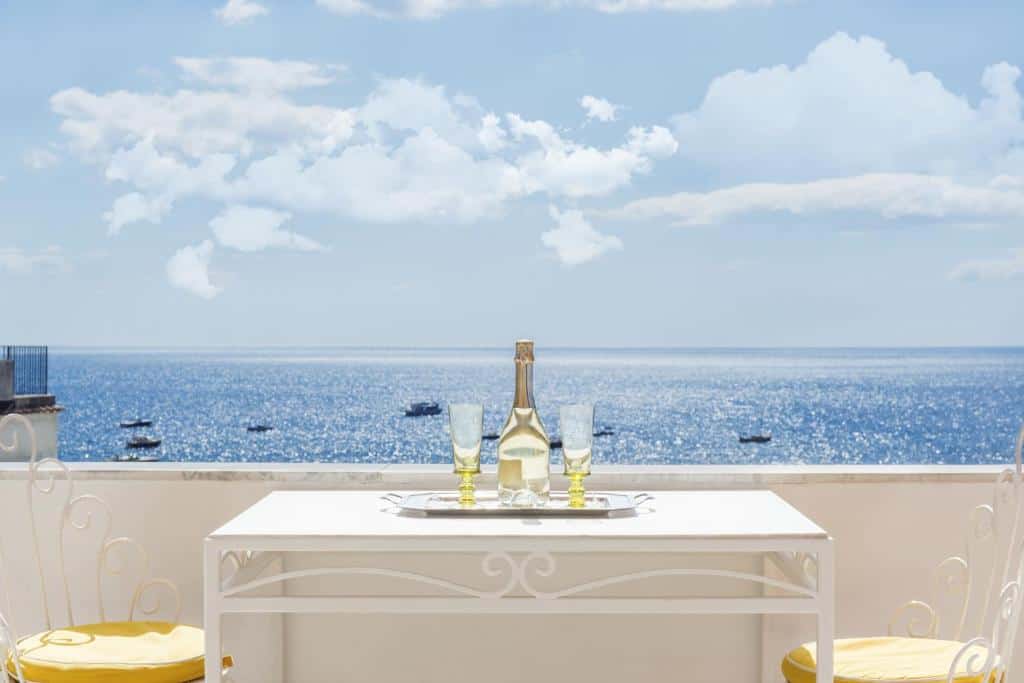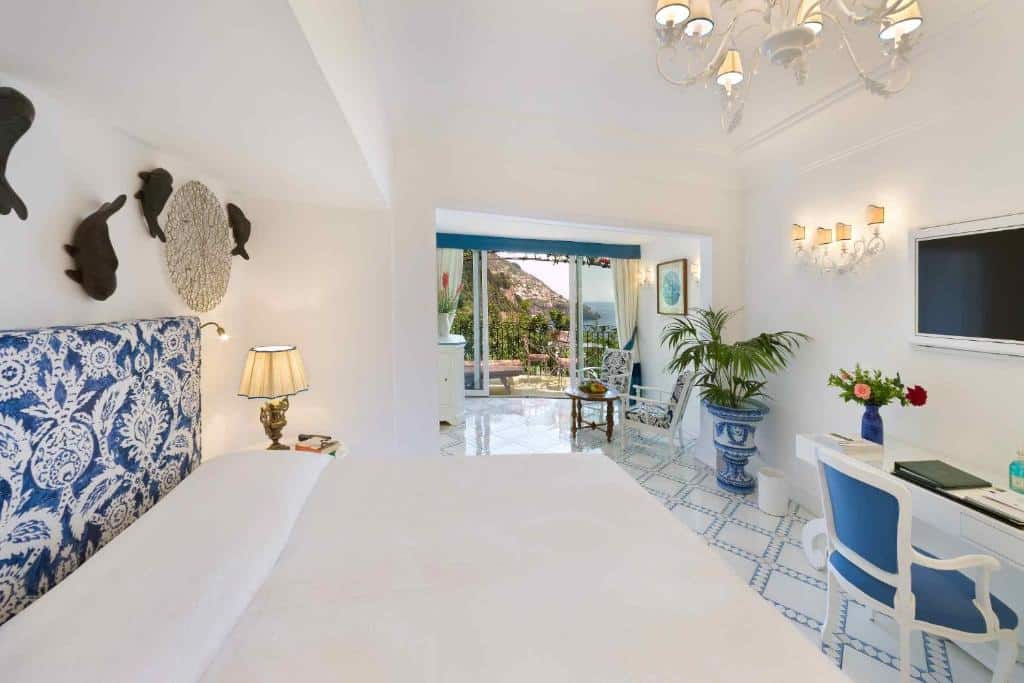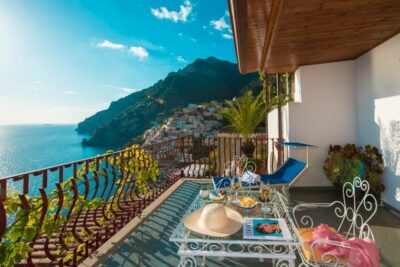The ancient maritime village of Positano, which has become one of the most elegant and iconic tourist destinations on the Amalfi Coast, stands in a stunning and evocative panoramic position along one of the most beautiful stretches of coastline on the Sorrento Peninsula, specifically in the center of the bay between Punta Germano and Capo Sottile. All around, as a crown, rise the verdant Monte Comune, Santa Maria del Castello, S. Angelo a tre Pizzi, Canocchia, Campo dei Galli and Paipo.
Its built-up area, unique because it is conceived on a vertical axis, presents itself to the eyes of the traveler as in an incredible pyramid overlooking the sea: the picturesqueness of an ancient nativity scene and the romantic atmosphere of a glamorous resort make Positano a seductive dream suspended between sea and sky.
On this page, you will find all the information you need to make the most of your travel experience to the most iconic and romantic destination on the Amalfi Coast.
Indice dei contenuti
How to get to Positano
✅ By car or motorcycle, it can be reached via State Road 163; about 60 km from Naples, 40 km from Salerno, 20 km from Amalfi and 15 km from Sorrento.
Be careful because, especially in high season, you may find traffic jams and limited parking spaces.
✅ From Naples the fastest public transportation to Positano is the circumvesuviana train to Sorrento where you can take the SITA buses on the line to Amalfi. From Salerno, on the other hand, you can reach Positano using the fast and convenient Travelmar ferries, or by SITA buses reaching Amalfi first, where you will change by taking the bus on the line to Sorrento.
📣 Your road free from queues: book the ferry!
Where to Sleep in Positano
📣Destination Positano?
We have selected the best accommodations for you!
What to See in Positano
Why did Positano, throughout the 20th century, attract so many artists?
Probably because in what appeared to be a small fishing village there was already a glimpse of that fascinating ambivalence that distinguishes it today: indeed, opposite energies and emotions coexist in the vertical town. Depending on how you look at it, Positano can seem sunny or dusky, worldly and glamorous or popular and picturesque, romantic or adventurous: all these impressions coexist confusingly and beautifully, in a unique landscape setting.
Because of its particular conformation, Positano can only be visited on foot, a trait that certainly contributes to its charm, because it forces one to slow down, to pause, to really savor that Dolce Vita that characterizes its long summers, made up of sunsets, slowness, small pleasures and great emotions.
📣 Don’t miss :
📍 The Church of Santa Maria Assunta
just a few steps from the Spiaggia Grande, it stands out for its iconic dome covered in yellow and blue slivered majolica. The three-aisled church holds some treasures, such as the Bust of St. Vitus by the Neapolitan School or some nativity scene shepherds dating back to the 1700s. On the high altar is the Byzantine icon of the Black Madonna and Child from the 12th century.
📍 The Church of Santa Caterina
located in the delightful Punta Reginella district, overlooking Via Pasitea, not far from Fornillo. This church was erected by local merchants who traded with Alexandria. For a long time it remained abandoned, later renovated. Of the original church, the 18th-century altar remains, while the neo-Gothic style that characterizes the entire building is the work of later restoration work. If you visit this church, know that at this district is famous for the artists who have stayed there: Massimo Campigli, Stravinsky (who, apparently, recovered from tuberculosis here), the ceramist Irene Kowaliska, creator of the renaissance of Vietrese ceramics.
📣 Other sacred monuments you might visit:
🔹 Church of St. James: in the “Liparlati” district. It is characterized by its bell tower covered with colored majolica tiles;
🔹 Church of the Holy Rosary, in the center of Positano;
🔹 Church of St. Peter, in the “Laurito” hamlet;
🔹 Church of Santa Margherita, in the “Fornillo” district;
🔹 Chapel of St. John the Baptist, with a majolica tiled Campanian terracotta floor, bearing a depiction of a Wind Rose;
🔹 Church of St. Matthew;
🔹 Church of Santa Lucia;
🔹 Chiesa Nuova: the church, dedicated to the Blessed Sacrament, gives its name to the entire district.
📍 Also of interest is the Roman Archaeological Museum of Positano.
Located just below the Church of Santa Maria Assunta, the Roman Archaeological Museum, opened in 2018, offers access to a 1st-century AD Villa and two crypts, one of which is medieval.
Of the Villa, covered by the 79 A.D. eruption, the triclinium, whose frescoes and floor mosaic remain clearly visible. The museum is open Monday through Sunday. To access the archaeological site there is an entrance fee that can be purchased online.
📍 The Saracen towers of Positano
Wandering around the historic center and the beaches, you will surely notice striking towers rising majestically above the sea: these are the Saracen towers of Positano, which in the 1500s assumed considerable importance for the protection of the local population from Saracen and Turkish pirates. Below we point them out,so you can recognize them when you see them!
📍 Clavel Tower (also known as Torre Fornillo):Swiss poet Gilbert Claver, visiting Positano in 1909, fell in love with a 16th-century tower that was part of the system of defensive towers that covered the entire Amalfi Coast. Fascinated by the shape of the tower and its pentagonal plan, which resembled an Egyptian pyramid, he purchased the tower with plans to make it a work of art, a monument to immortality. The project was entrusted to futurist Depero, who oversaw its decoration. The highly ambitious project was never fully completed. The tower was purchased in the 1950s by Princess Santa Borghese Hercolani, who until her death left the building intact, as Clavel had left it.
📍 Arienzo Tower: Located on the beach of Arienzo, this Saracen tower, with a circular base, defended the Mill that stood at this beach. Few remains are visible of the tower.
📍 Torre Trasita: this Saracen tower, which now houses a famous accommodation structure, dates back to the 16th century and is located between Marina Grande beach and Fornillo beach.
📍 Torre Sponda: in the opposite position from the previous one, you meet it along the road leading to the center of the village. It is the oldest of the Saracen towers, dating in fact from the 13th century.
What to Do in Positano
📣 Take a look at the best experiences we have selected for you in and around Positano!
Hiking and trekking in Positano
Positano is a great base for so many unforgettable excursions. Below, you will find the most important excursions. If you are a fan of trekking and want some more information on the subject, please read our article dedicated to excursions on the Amalfi Coast.
Today From Positano many trekking paths start and arrive; the best known of all is the Sentiero degli Dei (Path of the Gods), which starting from Agerola reaches, in the hills of Positano, the beautiful village of Nocelle with its characteristic little square in front of the church of S. Croce.
📍 The Path of the Gods

It starts from Bomerano (Agerola) and reaches the hamlet of Nocelle, from which, through a very long staircase (1500 steps!) you reach Positano. It surely represents the most famous trekking route on the Amalfi Coast and one of the most beautiful in the World. The evocative name is linked to myth: according to legend, in fact, the Greek gods passed through here to save Ulysses from the Sirens. The route takes about 4 hours of walking. If you want to learn more, read our detailed article on the Path of the Gods.
📍 On the summit of Montepertuso
Without doing much walking from the village you can reach the incredible ‘hole in the mountain,’ the natural arch, which gives its name to the high hamlet of Positano, which we will tell you about shortly.
The top of the mountain can be reached starting from the path that begins in the small square of Montepertuso: from here begins the walk that, between gardens and a few flights of stairs, leads to the famous hole in the mountain Gambera, from which to enjoy the wonderful spectacle of the view of the Amalfi Coast, which, on clear days, allows you to see the Faraglioni of Capri. From here, continuing further, you reach the top of the mountain, on which stands the Church dedicated to the Madonna delle Grazie.
📍 From Positano to Monte Comune
From the hamlet of Montepertuso you can also reach Monte Comune. The path starts from the locality known as “Capo D’acqua”: this stepped road passes through the villages of Monepertuso and Santa Maria del Castello. Crossing woods and terraces, stairs and climbs, you reach the agricultural area of Vico Equense, from which you can enjoy beautiful views that open up to the Amalfi Coast and the Goldo di Sorrento, as far as the Gulf of Salerno and Naples.
📍 Climbing between sky and sea
Using the extraordinary rock walls of the Positano area, more than 200 routes have been created, making it the most important sport climbing center in southern Italy, with routes of medium and high difficulty and easy routes for kids.
Unique experiences in Positano
Positano is the ideal place to indulge in la dolce vita, in a dreamlike landscape of wilderness where Mediterranean cottages and enchanting 18th-century palaces cling. The first advice we give you is to enjoy exploring the town quietly and slowly, lingering from time to time on glimpses, picturesque corners and colorful stores displaying local crafts.
You will surely be attracted by the riot of handcrafted dresses, hats and sandals, which you will see displayed in the windows of the many stores that brighten the streets of the village: resign yourself to buy something, because it is impossible to resist the allure of Positano Fashion, now famous throughout the World
Since the 1960s, the centuries-old tradition of linen and hemp weaving combined with that of embroidery and crochet has created a unique style of clothing that inimitably combines natural materials, bright colors and floral decorations. In Positano’s workshops, the original leather sandals are freshly and custom-made by skilled and experienced artisans.
From year to year, the collections are renewed in keeping with the tradition that has made Positano a world-renowned brand. Strolling through Positano’s picturesque narrow streets and stairways, you will be enraptured by the colors and beauty of its boutiques, where you can also find major international brands and handcrafted products typical of the Amalfi Coast, such as those of food and wine and ceramics.
In addition to a relaxing shopping tour, we remind you that from Positano, you can also plan sea excursions to the nearby Li Galli Islands, Marina del Cantone, the Bay of Ieranto, the other towns of the Amalfi Coast and – why not? – to Capri.
The area offers a wide choice of restaurants and clubs where you can taste the best specialties of Campania’s cuisine, while nightlife lovers can count on delightful places to spend the evening hours, sipping a drink and listening to good music.
The villages of Positano
The beach and the historic center definitely represent the most iconic places and will surely be the first ones you visit and immortalize with your phone camera.
After contemplating the narrow streets of the center, with its colorful stores and the splendid Church of the Assumption that looks out elegantly and gleaming over Marina Grande, we suggest you extend your visit: take the narrow streets and stairways that lead higher up, crossing Chiesa Nuova and Liparlati, Positano’s oldest districts, and reach the hamlets of Nocelle and Montepertuso, to enjoy the view from above, away from the crowds and in contact with nature.
📍 Montepertuso
The name comes from the curious hole (in local dialect “pertuso”) that opens in the mountain on which this quaint rural village towers. According to legend, the Devil himself, in order to impress the Madonna, allegedly attempted to pierce the mountain using only his own hands. Unsuccessful in his feat, he allegedly moved Our Lady to pity, who brushed against the mountain, creating precisely a gash there and causing the Devil to fall off the precipice.
On the top of the mountain stands the lovely Church of Santa Maria delle Grazie, which can be reached by a pleasant walk we have told you about in the appropriate section of this page.
📍 Nocelle
This is the highest part of Positano. The name alludes to the production of hazelnuts (“nocelle” in local dialect). The location of this hamlet, until a few years ago reachable only on foot via stairs and paths, made it a strategic point for sighting Turkish and Saracen ships in past centuries. A number of beautiful paths start from here, including the famous Path of the Gods.
The best beaches in Positano
✅ The main one is the iconic Marina Grande beach, overlooked by much of the town and where its picturesque alleys flow like streams.
✅ Not far from the center, reachable on foot, is the Fornillo beach scenically enclosed by the Fornillo Tower and the Trasita Tower; in the same direction, reachable by sea, are the stunning little beaches of Scogli Piani, Cavone and Remmese.
✅ To the east of the town, on the other hand, shrouded in Mediterranean scrub, the coastline is enveloped by a great many small beaches: Laurito, San Pietro, Arienzo, Fiumicello, La Porta, and Torre Sponda.
Events in Positano
Positano, especially during the warm season, offers festivals and entertainment for all tastes, between the sacred and the profane. Religious festivals take on the extraordinary character that unites them with those throughout southern Italy; the religious rite is always accompanied by entertainment and folklore that make them must-see events.
✅ Among the many festivals, we particularly mention the patronal celebration of the Assumption at Ferragosto with phantasmagorical fireworks at the sea, the feast of St. Peter on June 29, and Easter with the evocative procession through the city’s alleys.
✅ On August 15, during the celebrations dedicated to Santa Maria Assunta, an incredible fireworks display over the sea illuminates the town of Positano. Boat tours are organized for the occasion, allowing visitors to admire the fireworks display from the sea. An experience to be had at least once in a lifetime!
Why choose Positano as a travel destination
Positano impresses for many things: the striking and unique landscape, the lively social life that enlivens it from late spring until autumn, the charm of its beaches, and the unique possibility of being able to travel only on foot, by means of narrow streets and steps, precisely because of its particular conformation.
Today it represents a travel destination that has become iconic: a true dream location, a destination to visit at least once in a lifetime.
📣 Choose Positano if:
🔹 You are planning a couples trip and want it to be your trip of a lifetime;
🔹 You’re planning a surprise for your other half on a special date or a wedding proposal in style;
🔹 You are planning to visit both the Amalfi Coast and the Sorrento Coast (Positano is only 19 km from Sorrento and 16 km from Amalfi)
The best time to visit Positano
From spring to autumn, Positano is always a destination for tourists and travelers: the historic center, beaches, stores and clubs are always bustling with activity, which intensifies considerably in July and August.
📣 For this reason, our advice is to prefer the months of June and September to find the town quieter and less crowded, as well as a decidedly more pleasant climate.
Curious facts about Positano
One particular legend concerns the birth of the town’s name. According to tradition, in the 12th century a ship was carrying a picture of the Madonna on board. Just as it found itself in front of the village, a lull stranded the ship at sea. As the sailors tried to return to the open sea, they heard a voice say “Posa Posa.” (in our dialect it means: “Put it down!”).
The captain interpreted the strange prodigy as a sign of the Virgin’s will to stay there. Thus, the sailors reached the shore and handed the Positanese the icon of the Black Madonna, which was placed on the high altar of the Church.
The History of Positano: the Myth
Hailed by writers and poets, reproduced countless times on canvas, Positano remains largely unknown in the earliest stages of its existence.
As was often the case in the past, there are many myths that tell of its origin; one of these has Positano founded by Poseidon, the Greek god of the sea, out of love for the nymph Pasitea whom he loved.
However, it is quite certain that the territory of Positano was inhabited as early as prehistoric times, specifically in the Upper Paleolithic period, as ascertained by the findings of a large number of land and sea mollusks and the stone with an animal’s head engraved at La Porta cave in 1956-1957, Mezzogiorno cave in 1967-1968 and Erica cave in 1968-1969.
On the sea, it is surrounded by three islets: the Gallo Lungo, the Rotonda and the Castelluccio, long believed to be mythical abodes of the bewitching sirens.
The Roman villa found near the present mother church of Positano, and referred to in the April 23, 1758 report of Carlo Weber in charge of the excavations at Pompeii, and the numerous other vestiges of villas d’otium along the coast, attests to the fact that the Amalfi Coast was chosen as a summer residence by wealthy Romans, patricians or wealthy freedmen. Secure records date back to the centuries after the fall of the Roman Empire, when Positano became part of the Republic of Amalfi going through a prosperous period thanks to trade with other Mediterranean countries.
Unfortunately, the sad periods of the Angevin and Aragonese dominations and the increasingly ferocious raids of Saracens and Turks followed. To defend themselves, the people of Positano erected, by order of Viceroy Don Pedro de Toledo, three watchtowers that still stand today: those of Fornillo, Trasito and Sponda.
In 1668 Positano disbursed 12943 ducats to redeem itself from feudal burdens by declaring itself a royal city: it then opened the sea trade with Greece and the ‘Island of Cyprus, reactivated that with Calabria and Apulia, regaining great importance and prestige.
Until the end of the 19th century, the town was accessible only by sea or through impassable paths, such as the “Path of the Gods,” which in the past was an important way of communication with the towns beyond the mountains.
Since the construction of the rolling road, the first travelers began to appear in a short time: since the early 1900s there have been numerous artists and intellectuals who have come here to find rest or inspiration. Among them was Steinbeck, who visited on the advice of Alberto Moravia, who wrote of Positano, “When you happen to discover a place as beautiful as Positano, the first impulse is almost always to keep your discovery to yourself. You think, ‘If I tell about it, it will be filled with tourists.'”
In the end, that’s exactly what happened: within a few decades, the beauty of this place was on everyone’s lips and Positano quickly became the popular tourist destination that it is today, the place that when you return from your trip makes you say dreamily, “What a dream. You have to go there at least once in your life.”



